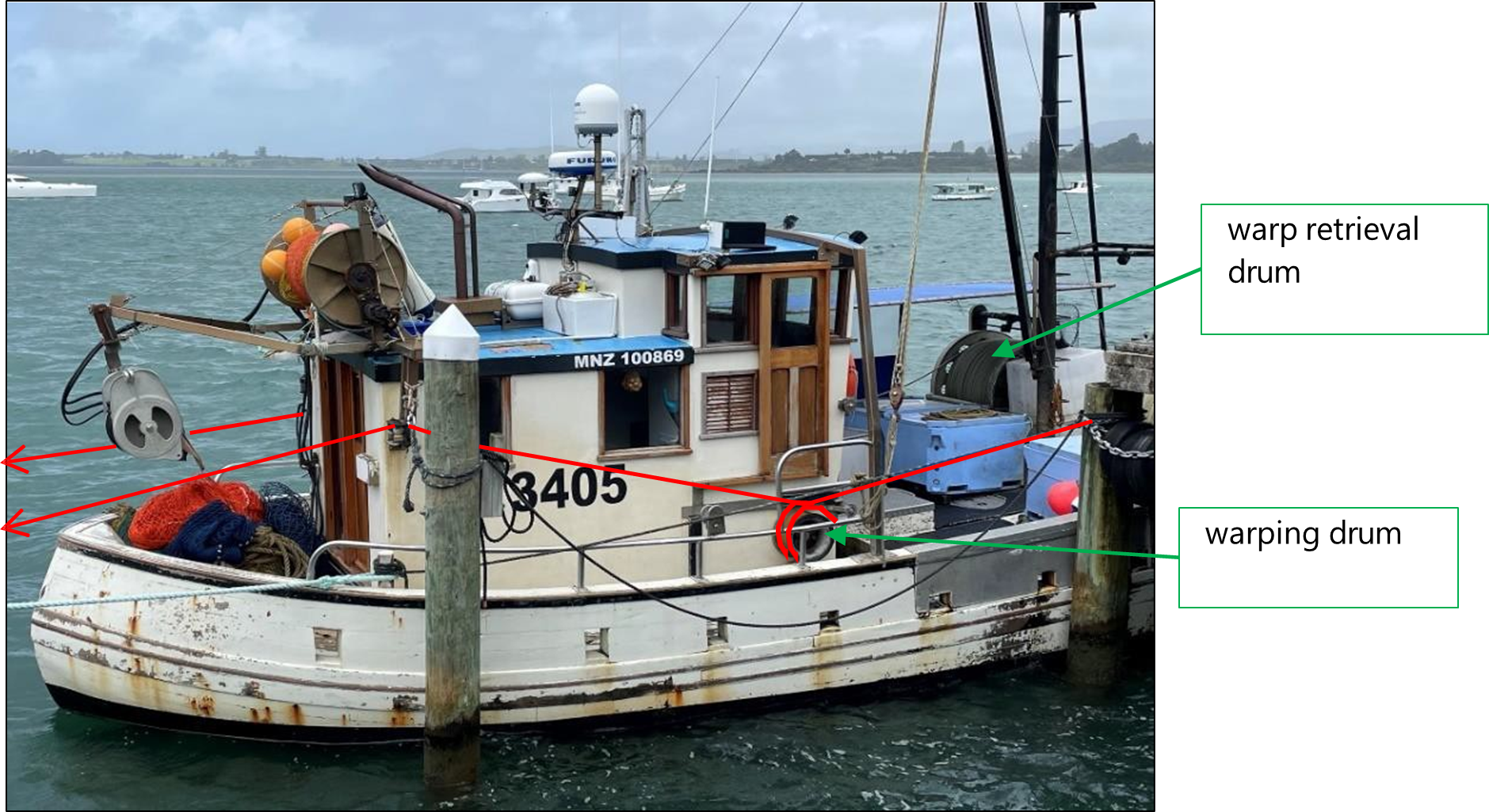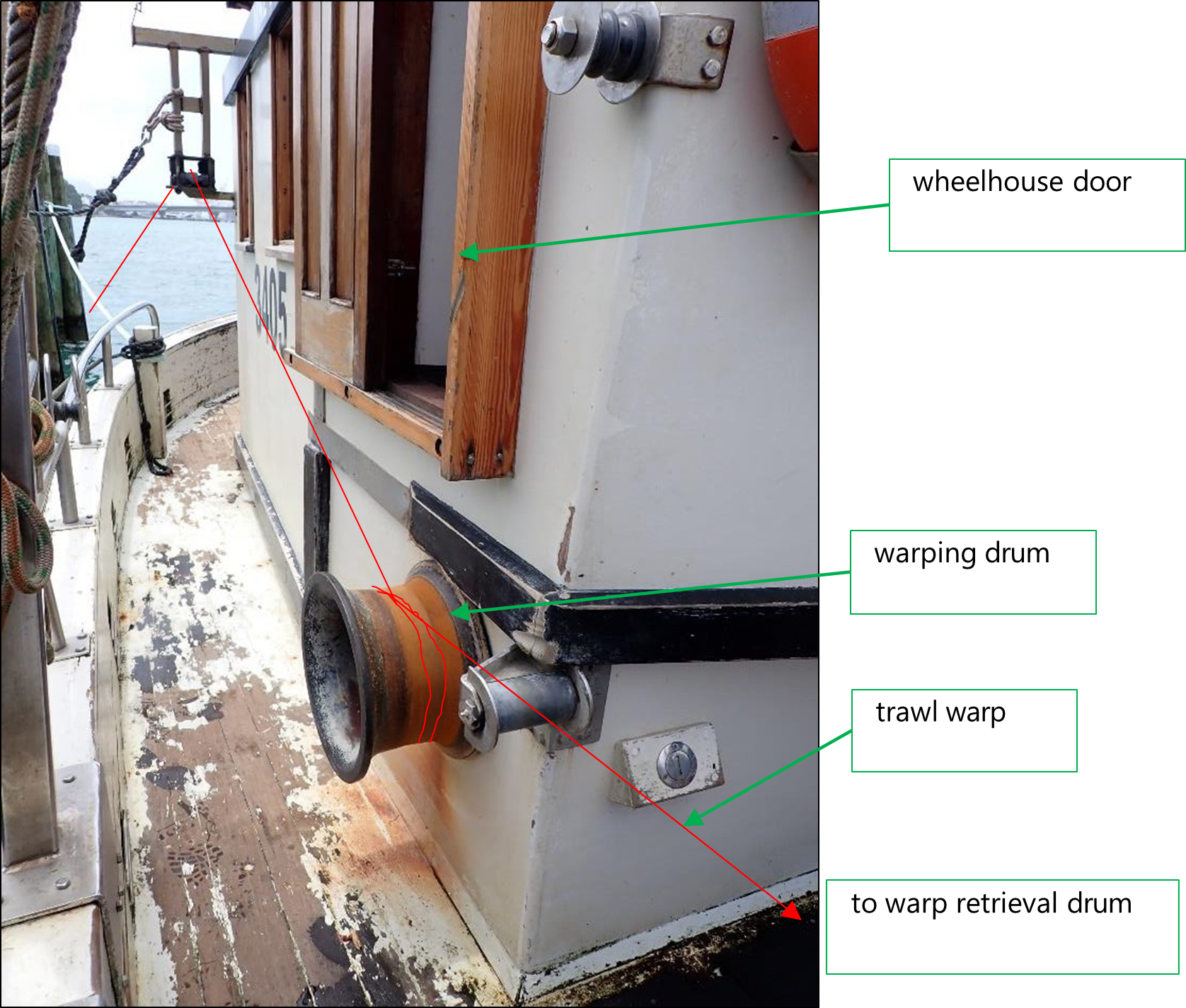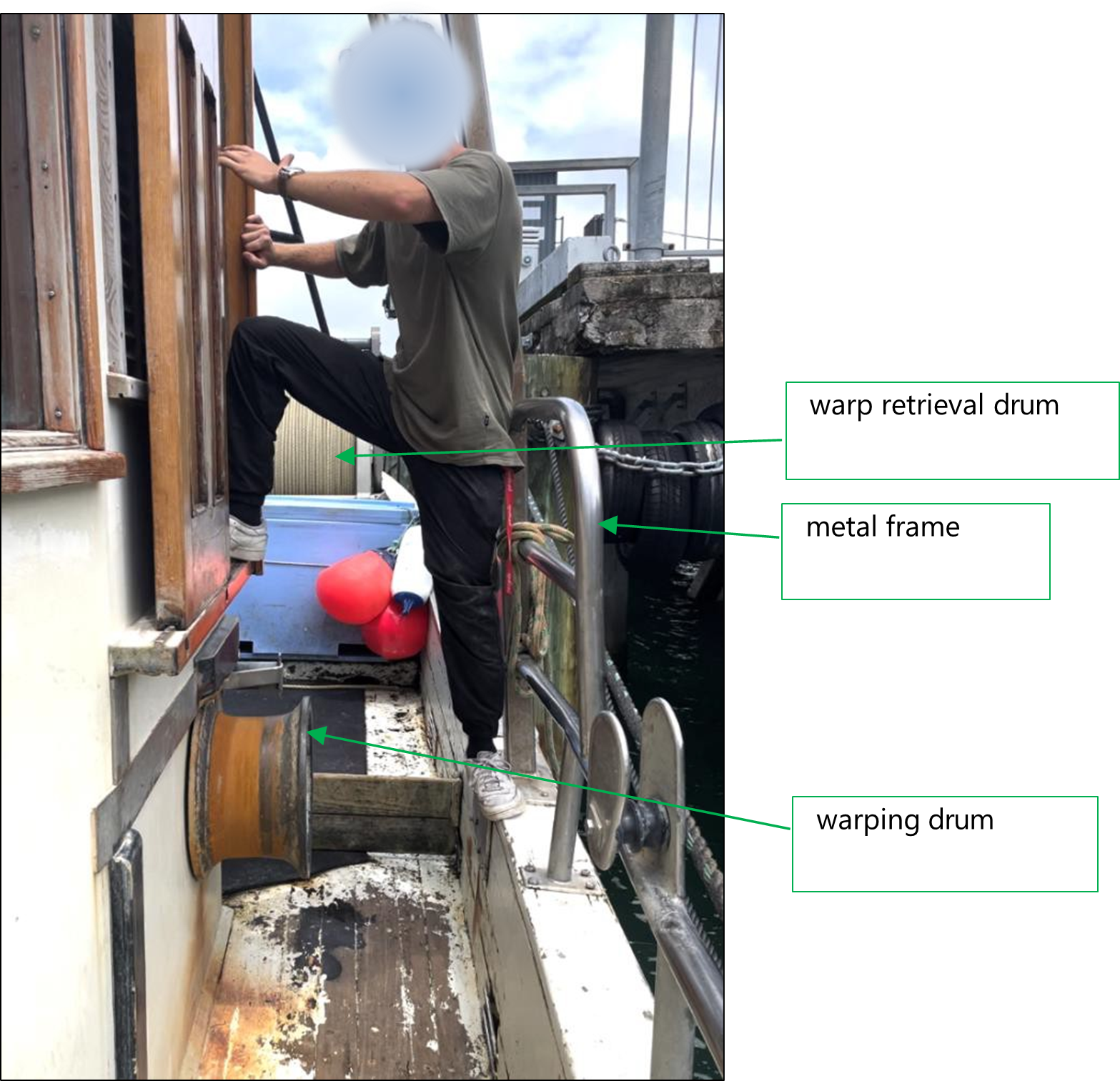On 12 December 2022 the Danish seine fishing vessel Boy Roel was fishing in the Bay of Plenty. While a net was being hauled from the seabed, the skipper climbed over the top of a winch to access the wheelhouse. The skipper’s leg became caught and was drawn into the rope that was hauling in the net as the rope wound around the winch drum. The skipper sustained multiple fractures and head injuries.
Executive summary Tuhinga whakarāpopoto


What happened
- On 12 December 2022 the Danish seine fishing vessel Boy Roel was fishing in the Bay of Plenty. While a net was being hauled from the seabed, the skipper climbed over the top of a winch to access the wheelhouse. The skipper’s leg became caught and was drawn into the rope that was hauling in the net as the rope wound around the winch drum.
- The skipper sustained multiple fractures and head injuries.
Why it happened
- The winch could only be controlled from the wheelhouse; there were no remote means to stop it operating in cases of emergency.
- The skipper was in a rush to access the wheelhouse and was distracted as they climbed over the winch.
- The bottoms of the skipper’s waterproof leggings were unsecured. This allowed them to be drawn into the rope as it wound around the winch.
What we can learn
- Unguarded winch arrangements on fishing vessels are hazards that must be thoroughly assessed to reduce the risk of harm.
- Seafarers should, where possible, avoid climbing over unguarded moving machinery and ropes and rigging under tension.
- Loose clothing is a significant hazard when working around running machinery.
- It is important that vessel operators conduct thorough risk assessments to identify and control all hazards that could result in harm.
Who may benefit
- Fishers and all other seafarers, fishing boat operators and anyone who works around moving machinery, may benefit from the findings in this report.
Factual information Pārongo pono
Narrative
- The Boy Roel was a 15.2 metre Danish seine fishing vessel that operated primarily out of Tauranga. The Danish seine fishing technique involves deploying a trawl warp over the stern. The leading end of the warp is attached to a buoy while the other end is attached to one end of a net. The net is then deployed to the desired sea depth using a trawl warp attached to its other end. The vessel then circles around and picks up the buoy, enabling the net and trawl warps to encircle the fis

- On board the Boy Roel, each trawl warp was wound several times around one of two warping drums, located on either side of the wheelhouse. The two warping drums were connected to a common shaft that ran through the engine room below the wheelhouse, driven by a single hydraulic winch motor. The speed and direction of the winch motor could be adjusted using a controller on a short lead in the wheelhouse.
- From the winch drum, each trawl warp was fed onto a large, hydraulically driven warp retrieval drum (see Figure 3). Each warp retrieval drum rotated to apply sufficient tension to the trawl warp to keep the turns tight around the warping drum. If the warp retrieval drums were exerting tension on the trawl warp, the trawl warp would be wound in by the rotating warping drum. If the tension were released (by slowing the speed of the warp retrieval drum), the trawl warp would surge (slip) on the warping drum and stop hauling the net. The speed of the warp retrieval drums could be adjusted from the wheelhouse (see Figures 3 and 4).

- Once this arrangement had been set up, the net would be drawn slowly across the seabed then winched to the surface at an increasing speed to prevent fish escaping ahead of the net.
- The Boy Roel departed from Tauranga at about 0630 on 12 December 2022, heading for its fishing area in the Bay of Plenty, about 20 nautical miles east-northeast of Tauranga Harbour. The skipper and two deckhands were on board. The deckhands rested while the skipper navigated to the fishing area. The weather was fine, with light variable winds and a low swell.
- Between 1000 and 1030 the crew deployed the net and began the seining process. By 1130 the winches had been set to haul the net from the depths at the maximum rate. The skipper and one deckhand were on the foredeck donning their wet-working gear in preparation for receiving the trawl net on board. The skipper had not fully secured their waterproof leggings when the net began to surface near the stern of the vessel sooner than expected. The skipper rushed towards the starboard door of the wheelhouse with the intention of slowing the winch speed. The skipper met the other deckhand, who was walking along the starboard-side deck towards the foredeck.
- A metal frame had been constructed on top of the bulwarks adjacent to the starboard wheelhouse door, to prevent the crew falling overboard while negotiating the large step up to the wheelhouse door. The skipper was looking at and explaining to the deckhand their intention to slow the winch as they stepped up on top of the bulwarks and up to the wheelhouse door. The skipper misplaced their feet, and the unsecured bottoms of their waterproof leggings became trapped in the trawl warp as it wound around the warping drum below (see Figure 5).

- The skipper’s leg was drawn in and trapped between the trawl warp and the warping drum. One of the deckhands, who was close by, saw what had happened and climbed up and over the entangled skipper and into the wheelhouse, where he stopped the winch.
- The two deckhands cut the skipper free from the trawl warp, moved them to the cabin and administered first aid. The skipper had suffered multiple fractures to their legs, feet and hands, and sustained head injuries.
- At 1215 one of the deckhands issued a Mayday call on VHF (Very High Frequency) Channel 16, which was answered by Maritime Radio at the Maritime Operations Centre in Wellington and passed on to the Rescue Coordination Centre New Zealand (RCCNZ).
- RCCNZ tasked a rescue helicopter operated by Northern Rescue Helicopters. The helicopter departed Auckland at 1322. Meanwhile, the two deckhands recovered the net and trawl warps from the sea and navigated the Boy Roel towards Tauranga at maximum speed.
- The rescue helicopter rendezvoused with the Boy Roel at 1352, and by 1431 two rescue swimmers/medics had been lowered into the water and boarded the Boy Roel. The medics began administering further first aid to the skipper.
- RCCNZ had also tasked Tauranga Coastguard with responding. A coastguard rescue vessel departed Tauranga at 1350 and rendezvoused with the Boy Roel at 1427. The first responders decided that the safest and most efficient method of evacuating the skipper was to transfer the skipper and the medics to the coastguard rescue vessel; this was achieved by 1508. The skipper was transferred to a waiting ambulance at Tauranga by 1520.
- The two deckhands navigated the Boy Roel back to Tauranga.
Personnel information
- The skipper had started fishing in the family business as a school leaver in 1995 and had been involved in the industry since. The skipper held a Skipper Restricted Limits certificate and had been operating the Boy Roel since 2009, taking ownership of the vessel in 2012.
- Both deckhands also had extensive experience in the fishing industry and held Skipper Restricted Limits certificates. They frequently crewed the Boy Roel on their own.
Organisational information
- Maritime New Zealand had issued the vessel owner with a Maritime Transport Operator Certificate (MTOC) under the company name of Kdee Limited. The MTOC was current at the time of the accident; it was due to expire in February 2026.
- The day-to-day operational management of the Boy Roel was carried out by Tauranga Fishing Limited (On 8 February 2023 the company changed its name to Two Lease Limited). Maritime New Zealand had approved a Maritime Transport Operator Plan (MTOP) for the Boy Roel.
- All the Boy Roel’s maritime documents and surveys were current at the time of the accident.
Analysis Tātaritanga
Introduction
- The following section analyses the circumstances surrounding the event to identify those factors that increased the likelihood of the event occurring or increased the severity of its outcome. It also examines any safety issues that have the potential to adversely affect future operations.
- The Boy Roel was compliant with all relevant maritime legislation for its type and operation and no mechanical or equipment failure contributed to the accident. The weather conditions were good. The crew were well rested, having slept at home the previous night, and were only about five hours into their first working day when the accident occurred.
- The controls for adjusting the speed and direction of the winches were in the wheelhouse. Once the winch arrangement had been set in operation, only an adjustment of the warping drum speed was required to control the rate at which the net was hauled to the surface. In this case, the warping drums had been set at maximum speed, as was normal when hauling a net to the surface.
- Three factors contributed to the skipper being entrapped by the trawl warp: haste; distraction; and loose clothing.
- The skipper was surprised by the net’s early arrival at the sea surface and was rushing to slow or stop the winch motor before it reached the stern of the vessel. At the time of the accident the skipper was looking at the deckhand and explaining their surprise instead of concentrating on the placement of their feet. The bottoms of the skipper’s waterproof leggings were unsecured and loose. Consequently, when the skipper misplaced their footing, the leggings became caught in the moving parts of the trawl.
- Risk management is important for the safety of a crew and a vessel. Thorough hazard identification is critical to effective risk management. If a hazard is not identified, it will not be assessed and may not be adequately controlled.
- If a hazard cannot be removed, the likelihood of it resulting in harm should be reduced to as low as reasonably practicable. Some effort should be put into reducing the consequences of a hazard arising. As a general guideline, it is good industry practice to put 80 per cent of effort into prevention and 20 per cent into mitigating the consequences.
- The Boy Roel crew were in the habit of climbing over the rotating warping drum on the starboard side to gain access to the wheelhouse while fishing. They were aware that the trawl warp winding around the rotating warping drum was a hazard to be avoided, but this hazard had not been documented in the MTOP hazard register and had not been adequately addressed.
- The hazard could not be removed, as these components were essential for the purpose of catching fish. However, several measures could reasonably have been taken to reduce the likelihood of this accident occurring. Examples include forbidding crew from routinely accessing the wheelhouse via the outside doors when the warping drums were moving and instead accessing the wheelhouse from the aft working deck via the cabin; and providing an alternative method for controlling the winches outside the wheelhouse by duplicating the controls outside the wheelhouse or lengthening the remote winch control to allow more freedom of control.
- There was no emergency stop for the winch motor. If emergency stops had been located in key working areas, the skipper might have been able to stop the winches without accessing the wheelhouse, or a deckhand might have been able to stop the winch sooner and potentially reduce the severity of the skipper's injuries, and not put themselves at similar risk when climbing into the wheelhouse door.
- Since the accident, the operator has constructed a platform over the warping drums to aid crew in accessing the wheelhouse from the deck. The procedures in the MTOP have also been amended to forbid crew accessing the wheelhouse through the side doors when warping drums are being operated.
- The operator is also exploring technical and/or procedural changes to ensure the crew always has the ability to control or stop winches in an emergency.
- The Transport Accident Investigation Commission (the Commission) is of the view these safety actions have addressed the safety issues identified, and therefore no recommendation has been made.
Findings Ngā kitenga
- There was no evidence of mechanical or equipment failure contributing to the accident.
- The qualifications and experience of the crew exceeded those required under the Boy Roel’s Maritime Transport Operator Plan.
- The skipper misplaced their footing while climbing over moving machinery under load and became entangled in the trawl warp as it wound onto the warping drum. Haste, distraction and wearing loose (unsecured) waterproof leggings were factors contributing to the accident.
- The obvious hazard of climbing over moving machinery had been identified but had not been adequately assessed and controlled. There were several measures the operator could have taken to reduce the risk to as low as reasonably practicable.
Key lessons Ngā akoranga matua
General
- Unguarded winch arrangements on fishing vessels are hazards that must be thoroughly assessed to reduce the risk of their resulting in harm.
- Seafarers should, where possible, avoid climbing over unguarded moving machinery or ropes and riggings under tension.
- The wearing of loose clothing is a significant hazard when working around running machinery.
- It is important that vessel operators conduct thorough risk assessments and identify and control all hazards that could result in harm.
Data summary Whakarāpopoto raraunga
Name
Boy Roel
Length
15.24 metres
Breadth
5 metres
Gross tonnage
45 tonnes
Built
1971
Propulsion
126 kw Gardner 8LXB diesel engine driving a single fixed-pitch propeller
Owner/operator
Tauranga Fishing Limited
Port of registry
Tauranga
Minimum crew
2
Type
Danish seine fishing vessel
Class
Fishing
Limits
Bay of Plenty, Auckland and Barrier inshore limits
Details
Date and time
Location
about 17 nautical miles east-northeast off Tauranga
Harbour
Harbour
Injuries
1
Persons involved
3
Damage
nil
Conduct of the inquiry He tikanga rapunga
- On 12 December 2022 Maritime New Zealand notified the Commission of the occurrence. The Commission subsequently opened an inquiry under section 13(1) of the Transport Accident Investigation Commission Act 1990 and appointed an investigator in charge.
- On 13 December 2022 two investigators travelled to Tauranga. There they conducted an inspection of the Boy Roel, interviewed the two deckhands who were on board when the accident occurred and gathered company documents.
- On 23 December 2022 one investigator travelled to Tauranga and interviewed the skipper of the Boy Roel at Tauranga Hospital.
- On 28 June 2023 the Commission approved a draft report for circulation to three interested parties for their comment.
- All three interested parties responded that they had no comment.
- On 22 August 2023 the Commission approved this report for publication.
Glossary Kuputaka
- Bulwarks
- Solid handrails.
- Starboard
- The right side of a vessel when the viewer is facing forward
- Stern
- The rear of a vessel.
- Warping drum
- Devices that provide power to haul on a rope or cable.
- Trawl warp
- A synthetic rope used to haul in trawl fishing nets
